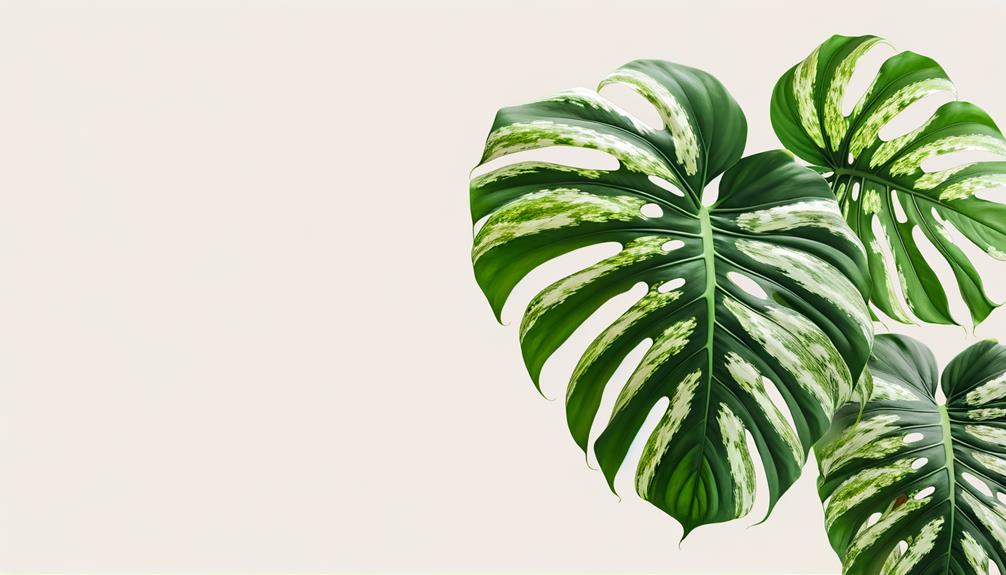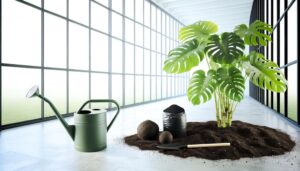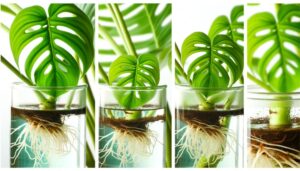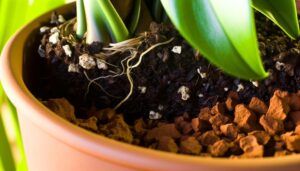Monstera Variegated Borsigiana Mother Plant
Your Monstera Variegated Borsigiana mother plant, hailing from Central and South American rainforests, thrives under specific conditions. It prefers high humidity and indirect light to maintain its striking white or cream variegation.
Use a well-draining potting mix, positioning it near an east-facing window with sheer curtains to diffuse sunlight. Regularly inspect for pests like spider mites and aphids, using insecticidal soap as needed.
For propagation, select a healthy stem segment with a node and aerial root, placing cuttings in water. Stay vigilant on pruning, lighting, and watering needs, and your plant will flourish.
Continue to explore for in-depth care techniques.

Key Takeaways
- Variegated Borsigiana features striking white or cream variegation on its leaves.
- Thrives in humid, shaded environments with indirect sunlight.
- Requires well-draining soil and regular watering when the top 2 inches of soil are dry.
- Prune regularly and use water-soluble fertilizer monthly for optimal growth.
- Propagate with healthy stem cuttings that include a node and aerial root.
Origin and History
The Monstera variegated Borsigiana, an enchanting cultivar of the Monstera deliciosa, originates from the tropical rainforests of Central and South America. In these humid, shaded environments, it thrives by climbing trees and absorbing diffuse light.
You'll find its variegation—a genetic mutation—highly prized for its aesthetic appeal. The plant's natural habitat provides you with clues for its ideal cultivation. Mimic rainforest conditions by ensuring high humidity, indirect light, and well-draining soil rich in organic matter.
Regularly mist the leaves and maintain temperatures between 65-85°F. You need to support its climbing habit with a moss pole or trellis. By replicating these conditions, you'll foster healthy growth and vibrant variegation in your Monstera variegated Borsigiana.
Identifying Features
When identifying a Monstera Variegated Borsigiana, you'll want to pay close attention to its leaf color patterns, which typically display striking white or cream variegation. Note the unique variegation traits, such as marbling or sectoral patterns, that distinguish it from other Monstera varieties.
Additionally, observe the growth habit indicators, including internode spacing and leaf shape, to confirm its distinct characteristics.
Leaf Color Patterns
Characterized by their unique variegation patterns, Monstera Variegated Borsigiana leaves display a mesmerizing blend of green and creamy white hues that serve as key identifying features. You'll notice that the chlorophyll distribution varies, creating a marbled effect.
Healthy variegation appears as irregular splashes, sectors, or even half-moon shapes. Maintain consistent light exposure to preserve these vibrant colors. Direct sunlight might scorch the white sections due to their lack of chlorophyll. Indoor cultivation under bright, indirect light is ideal.
Monitor leaf color changes as indicators of plant health. Yellowing or browning may signal stress or nutrient deficiencies. Regularly inspect the leaves for pests, which can disrupt the variegation patterns. Proper care guarantees the longevity and aesthetic appeal of your Monstera.
Unique Variegation Traits
Monstera Variegated Borsigiana's unique variegation traits include irregular splashes, sectors, and half-moon shapes that differentiate it from other variegated plants. When identifying these features, you'll notice the distinct pattern of chlorophyll distribution. Variegation can range from stark white to creamy yellow against the green leaf tissue. This distinct pigmentation results from genetic mutations affecting chloroplast development. To better understand:
| Variegation Type | Description | Example Plants |
|---|---|---|
| Irregular Splashes | Random, uneven white/yellow patches | Monstera Albo Borsigiana |
| Sectors | Defined, segmented variegated areas | Monstera Thai Constellation |
| Half-Moon Shapes | Semi-circular variegation covering half | Monstera Deliciosa |
Growth Habit Indicators
You can identify the growth habit of Monstera Variegated Borsigiana by observing its climbing tendencies and aerial root development. This plant exhibits a vining growth pattern, producing elongated stems that attach to supports using aerial roots. These roots emerge from nodes along the stem and anchor into nearby surfaces, facilitating vertical growth.
When cultivating, provide a moss pole or trellis to encourage healthy climbing behavior. Leaf morphology also signals growth habits; juvenile leaves are smaller and less fenestrated, while mature leaves become larger with characteristic splits and holes.
Regular pruning and strategic light exposure can control and optimize growth. Monitoring these indicators makes sure you're fostering robust development and maintaining the plant's aesthetic appeal.
Ideal Growing Conditions
To achieve peak growth for your Variegated Borsigiana, make certain it receives bright, indirect sunlight and is kept in a well-draining soil mix. Position it where it can get at least six hours of diffused light daily, avoiding direct sun to prevent leaf burn. Utilize a soil blend that incorporates peat, perlite, and orchid bark to guarantee ideal aeration and drainage.
Maintain ambient temperatures between 65-80°F (18-27°C). Humidity levels should be around 60%, as this mimics its native tropical environment. Regularly rotate the plant to ensure even light exposure, promoting uniform growth.
Support your Monstera with a moss pole or trellis to encourage vertical development. By providing these conditions, you'll nurture robust foliage and vibrant variegation in your Variegated Borsigiana.
Watering Requirements
Adequate hydration is essential for your Variegated Borsigiana, demanding a consistent watering schedule to maintain soil moisture without causing waterlogging. Monitor soil moisture levels frequently using a moisture meter; the substrate should be kept slightly damp but not saturated.
Water your plant when the top 1-2 inches of soil feel dry to the touch. Guarantee proper drainage by using a well-aerated potting mix rich in organic matter, such as a combination of peat, perlite, and orchid bark. Overwatering can lead to root rot, so avoid letting the plant sit in standing water.
Adjust your watering frequency based on seasonal changes and indoor humidity levels to optimize the plant's hydration needs and promote healthy growth.
Light Needs
For best growth, place your Monstera Variegated Borsigiana in bright, indirect light to mimic its natural habitat.
Avoid exposing it to direct sunlight, as this can cause leaf burn and chlorophyll degradation.
If you're growing it indoors, make sure it receives filtered light or supplement with grow lights to maintain its variegation.
Optimal Light Conditions
Ensuring your Monstera Variegated Borsigiana mother plant thrives requires providing it with bright, indirect light for ideal growth and variegation. This cultivar, known for its striking variegated foliage, relies on sufficient light to maintain its unique coloration.
Position your plant near an east or north-facing window, where it can receive filtered sunlight. Utilize sheer curtains to diffuse the light, mimicking the plant's natural understory habitat. Aim for around 10,000 to 20,000 lux of light intensity, using a light meter for precision.
If natural light is inadequate, consider full-spectrum grow lights to supplement. Remember, the balance of light intensity and duration is essential for photosynthesis, promoting robust growth and maintaining the vibrant variegation characteristic of this Monstera variety.
Avoiding Direct Sunlight
Direct sunlight can cause leaf scorch and hinder the variegation of your Monstera Variegated Borsigiana, so it's crucial to protect the plant from intense, unfiltered rays. When exposed to direct sunlight, the chlorophyll in the leaves can degrade, leading to photosynthetic inefficiency.
Utilize sheer curtains or position the plant in an east-facing window where it receives diffused light. Aim for bright, indirect light conditions to promote optimal variegation and growth. You can rotate the plant periodically to make sure even light distribution across all leaves.
If you notice any signs of leaf burn, such as browning edges or bleached patches, immediately adjust its location. Monitoring light exposure will help maintain the plant's aesthetic appeal and health.
Indoor Light Adaptation
Understanding the Monstera Variegated Borsigiana's indoor light adaptation is important to optimize its variegation and photosynthetic efficiency. You need to provide bright, indirect light to ensure best growth.
Variegated sections contain less chlorophyll, which reduces photosynthetic capacity. Place your plant near an east-facing window or use sheer curtains to diffuse direct sunlight from south or west-facing windows.
Monitor leaf color and adjust light exposure accordingly; too little light can cause reversion to green, while too much can lead to leaf burn. Employing grow lights with a spectrum of 400-700 nm (PAR range) can help maintain consistent light levels.
Soil and Potting
To optimize the growth of your Monstera Variegated Borsigiana, choose a well-draining potting mix rich in organic matter. A suitable mix typically includes components that secure aeration, moisture retention, and nutrient availability.
Here's a recommended potting mix composition:
| Component | Percentage | Function |
|---|---|---|
| Peat Moss | 40% | Retains moisture, organic |
| Perlite | 30% | Enhances drainage, aeration |
| Pine Bark | 30% | Provides structure, nutrients |
Combine these components to create an ideal growing medium. Make sure your pot has drainage holes to prevent waterlogging, which can lead to root rot. Repotting should occur every 1-2 years to replenish nutrients and accommodate growth. Monitor soil moisture; water when the top 2 inches are dry to the touch.
Pruning and Maintenance
Proper trimming and maintenance of your Monstera Variegated Borsigiana secure vigorous growth and aesthetic appeal. Begin by sterilizing your trimming shears to prevent contamination.
Carefully remove any yellowing or damaged leaves, cutting just above a node to encourage new growth. Regularly trim aerial roots, but avoid excessive removal to maintain structural stability. Monitor internodal spacing; if stems elongate excessively, trim to promote bushier growth.
Use a balanced, water-soluble fertilizer monthly to support strong development. Guarantee ideal light conditions, as insufficient light can result in leggy stems. Rotate the plant periodically for even light exposure.
Common Pests and Diseases
Combating pests and diseases in your Monstera Variegated Borsigiana is crucial for maintaining its health and preventing irreversible damage. Spider mites, aphids, and mealybugs are common pests that can infest your plant. Regularly inspect the undersides of leaves and stems for these invaders. Use insecticidal soap or neem oil to eliminate them.
Fungal diseases such as root rot can occur due to overwatering. Ensure proper drainage and avoid waterlogged soil to prevent this issue. Bacterial leaf spot is another concern; remove affected leaves and maintain good air circulation.
Propagation Techniques
Mastering propagation techniques for your Monstera Variegated Borsigiana guarantees you can successfully cultivate new plants from your existing mother plant. Begin by selecting a healthy stem with at least one node and an aerial root. Use sanitized pruning shears to avoid contamination.
Place the cuttings in water or a well-draining potting mix to encourage root development.
Key steps to keep in mind:
- Select a node: Ensures new growth points.
- Sanitize tools: Prevents disease transmission.
- Rooting medium: Water or soil; each has specific benefits.
- Humidity control: High humidity promotes root formation.
- Light conditions: Indirect, bright light is ideal.
Monitoring these factors closely will enhance your success in propagating Monstera Variegated Borsigiana.
Conclusion
Caring for your Monstera variegated borsigiana mother plant is like nurturing a rare gem; it demands attention to detail. Make sure it's placed in bright, indirect light, and maintain consistent watering to keep the soil moist but not waterlogged.
Regularly inspect for pests and prune to encourage healthy growth. By following these precise cultivation techniques, your Monstera will flourish, displaying its stunning variegation and robust health. Your dedication will unquestionably produce a breathtaking botanical masterpiece.






